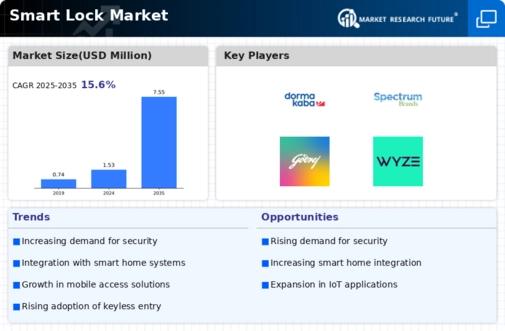Market Share
Smart Lock Market Share Analysis
In the competitive landscape of the Smart Lock market, companies employ various market share positioning strategies to establish their presence and gain a competitive edge. One prominent strategy is differentiation through technological innovation. Companies strive to develop and introduce advanced features that set their smart locks apart from competitors. Whether it's the integration of biometric authentication, sophisticated encryption methods, or enhanced connectivity options, technological innovation becomes a key driver in capturing market share. By offering unique and superior features, companies can attract consumers looking for cutting-edge solutions and stay ahead in the highly dynamic smart lock market.
Furthermore, pricing strategies play a pivotal role in market share positioning. Some companies opt for a cost leadership approach, offering smart locks at competitive prices to appeal to price-sensitive consumers. On the other hand, premium pricing strategies target consumers who prioritize quality, brand reputation, and advanced features. Striking the right balance between pricing and perceived value is crucial for companies aiming to capture a significant market share, as it allows them to cater to diverse consumer segments with varying preferences and budget constraints.
Market segmentation is another key strategy employed in the Smart Lock market. By identifying specific consumer needs and preferences, companies can tailor their products to distinct market segments. For instance, a company may focus on developing smart locks suitable for residential applications, emphasizing features like ease of use and aesthetics. Simultaneously, another company may target the commercial sector, emphasizing robust security features and scalability. Effectively addressing the unique requirements of different market segments enables companies to solidify their positions within specific niches, optimizing their market share.
Strategic partnerships and collaborations are instrumental in market share positioning within the Smart Lock industry. Companies often seek alliances with other technology providers, smart home ecosystem developers, or security solution providers to expand their product offerings and enhance overall value. Integration with popular smart home platforms and compatibility with a wide range of devices can significantly broaden the market reach and appeal of smart locks. Establishing such strategic partnerships not only boosts market share but also contributes to the overall growth and acceptance of smart lock technologies in the broader market.
Brand positioning and marketing strategies also play a crucial role in shaping market share within the Smart Lock industry. Building a strong and recognizable brand helps instill confidence in consumers, influencing their purchasing decisions. Companies invest in marketing campaigns that highlight the unique features, reliability, and security of their smart locks. Additionally, effective communication of a brand's values and commitment to customer satisfaction can foster brand loyalty, encouraging repeat business and positive word-of-mouth recommendations, further solidifying market share.
Geographic expansion is another strategy adopted by companies to increase market share in the Smart Lock market. As smart home technologies gain global acceptance, companies seek to enter new markets and capitalize on untapped opportunities. Adapting products to meet the specific needs and preferences of different regions, complying with local regulations, and establishing a strong distribution network are essential components of successful geographic expansion strategies. By strategically entering new markets, companies can diversify their customer base and enhance their overall market share.







Leave a Comment